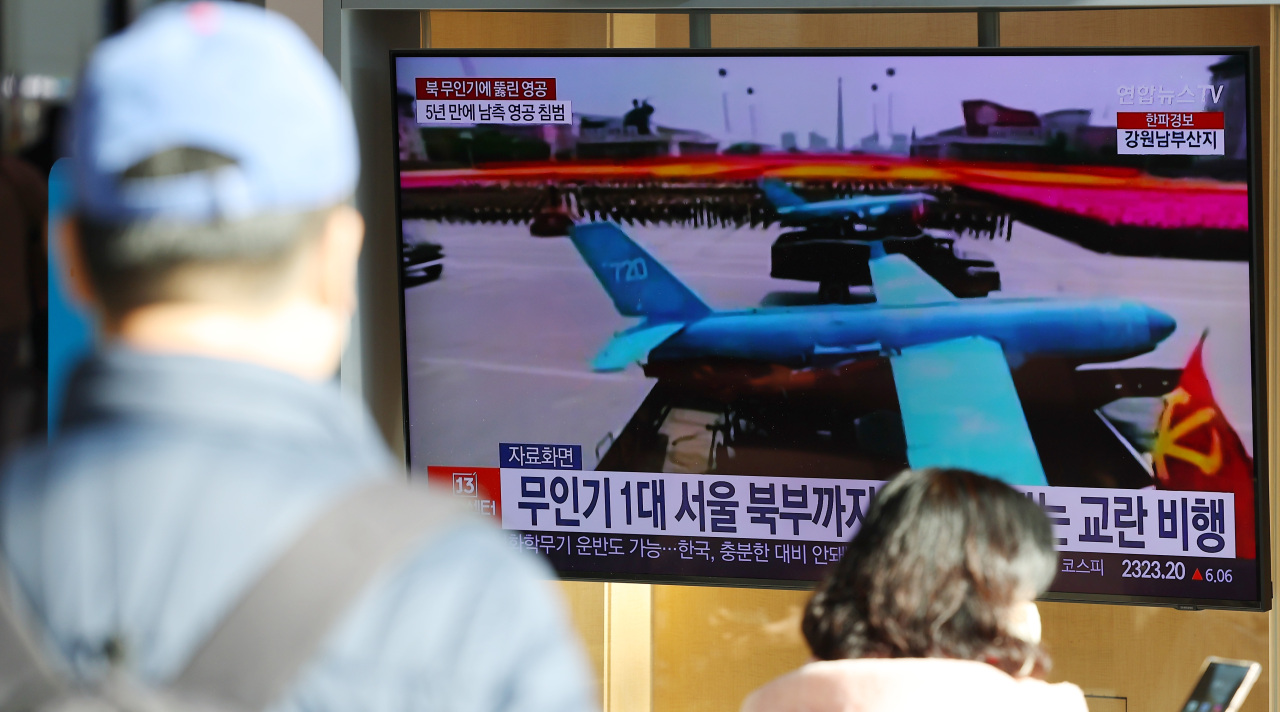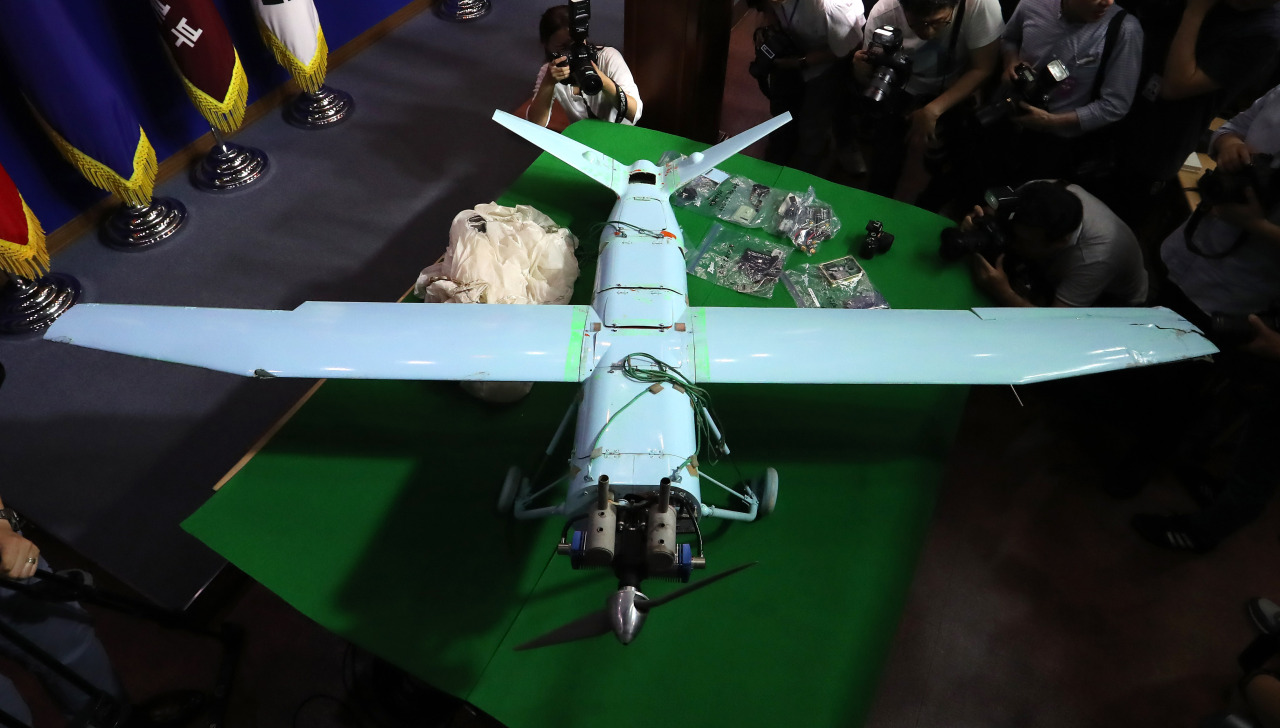
“The lack of our military’s preparedness has caused a lot of concerns to the public,” Kang Shin-chul, director of operations for South Korea’s Joint Chiefs of Staff, said during a televised briefing.
The South Korean military is able to detect and bring down enemy attack unmanned aerial vehicles, UAVs, that pose substantial threats to South Korea with its existing assets.
But Kang openly admitted the military’s limited capabilities in detecting and intercepting small UAVs designed for aerial reconnaissance.
Speaking at the Cabinet meeting, President Yoon Suk-yeol on Tuesday said the infiltration of North Korean uncrewed combat aerial vehicles showed the “extreme lack of the military’s readiness posture and training for the past several years.”
He also blasted the military for not conducting related training exercises to counter threats emanating from North Korean UAVs and for insufficient efforts to develop such capabilities.
Five North Korean UAVs on Monday intruded into South Korean airspace for the first time since 2017 and flew over densely populated Seoul and residential areas along the western inter-Korean border.
In response, the South Korean military scrambled Air Force fighter jets and attack helicopters. In the process, one KA-1 light attack aircraft crashed after taking off from its air base.
South Korea’s ground-based air defense systems, including vulcan automatic cannons and K30 Biho self-propelled anti-aircraft guns, did not work at all as they were unable to detect and track North Korean UAVs.
The military also fired around 100 shots from an attack helicopter toward a North Korean drone in the area near the island of Ganghwado, Incheon. But the South Korean military failed to shoot down the five North Korean UAVs.
One was believed to have returned to North Korea as of Monday afternoon, whereas the South Korean military has been uncertain about the whereabouts of the other four.

The South Korean military’s delayed assessment of unidentified objects after detection, however, would be one of the main reasons for missing the right time to bring down the UAVs before they entered village areas, Shin Jong-woo, a senior analyst at the Korea Defense and Security Forum, told The Korea Herald.
Shin said there would be considerable limitations in intercepting UAVs with airburst ammunition if they fly over residential areas.
“If shells explode in the air, their debris falls to the ground. Because of that, the military would see difficulties in intercepting unmanned aerial vehicles with concern over civil damages,” Shin said, elucidating that the falling debris could take a toll on civilians.
“In that regard, I understand the military’s decision. I don’t think we can justify causing civil damages to bring down a North Korean unmanned aerial vehicle.”
But Choi Hyun-ho, a military columnist at the JoongAng Ilbo, underscored that there has been almost no improvement in expanding defense means to bring down or intercept UAVs should they intrude past the inter-Korean border.
“The infiltration of North Korean drones proved that the South Korean military’s capability to detect has been enhanced, but it seems that there were no other means left to intercept the drones despite the military’s explanation about its concern about civil damages,” Choi told The Korea Herald.
Choi explained the South Korean military deployed Israeli-made secondary surveillance radar in the Greater Seoul area and enhanced detection capabilities of the local air defense radar in the aftermath of the intrusion of North Korean UAVs in 2014.
“In conclusion, the military needs to make fundamental and major shifts in its counter-drone operations,” Choi said.
Yang Uk, an associate research fellow at the Asan Institute for Policy Studies think tank, said the South Korean military should figure out an “effective system to destroy miniature unmanned aerial vehicles.”
The South Korean military is not ready in terms of both equipment and tactics to hit small UAVs with pinpoint accuracy, which is rather analogous to counterterrorism operations.
“But first and foremost, the South Korean military should develop its capability to incapacitate small unmanned aerial vehicles by utilizing the existing counterterrorism capabilities of the military, the police and the private sector,” Yang told The Korea Herald.
More fundamentally, Yang pointed out the reality that a project to build systems to counter threats posed by small UAVs has been relegated to a lower priority amid North Korea’s escalating nuclear and missile threats.
“The military has been aware of (the threats), but had to put such a project on the back burner,” Yang said.
“The military has a lot of projects to do, but it has been laser-focused to counter high-intensity threats posed by North Korean nuclear weapons and missiles. In fact, miniature unmanned aerial vehicles have little military utility.”
South Korea’s finalized defense budget for 2023 set a 4.4 percent on-year increase to around 57.1 trillion won ($42.3 billion), as approved by the Cabinet on Tuesday morning, the Defense Ministry said. Expenditures for establishing an indigenous three-axis defense system rose by 10.2 percent to around 5.3 trillion won.
Speaking at the Cabinet meeting, Yoon said the National Assembly had halved 2023’s proposed defense budget for counter-drone operations, and pledged to convince the National Assembly to increase the budget.
Yoon also pledged to expedite his plan to “establish a drone unit to carry out surveillance and reconnaissance operations on North Korea’s key military facilities” due to the infiltration of North Korean UAVs.
The president also laid out his plan to strengthen the South Korean military’s surveillance and reconnaissance capabilities by developing and deploying high-tech stealth drones.
But South Korean officials elucidated that the military will expand and reshuffle a drone robot-based battle group that has been operated under the auspices of the South Korean Army.
In addition, Kang from the JCS said the military will actively operate its assets for early detection of North Korean UAVs and “aggressively” deploy strike assets during the briefing.
The military also vowed to effectively and comprehensively operate its military assets to bring down enemy UAVs without causing civilian damage and regularly conduct the JCS-led joint air defense drills.
Notwithstanding its commitment, the South Korean military on Tuesday afternoon scrambled fighter aircrafts to hit suspected North Korean UAVs that flew over Ganghwa County, Incheon Metropolitan City, after initial detection. But the flight trails later turned out to be a flock of birds.





![[Graphic News] More Koreans say they plan long-distance trips this year](http://res.heraldm.com/phpwas/restmb_idxmake.php?idx=645&simg=/content/image/2024/04/17/20240417050828_0.gif&u=)